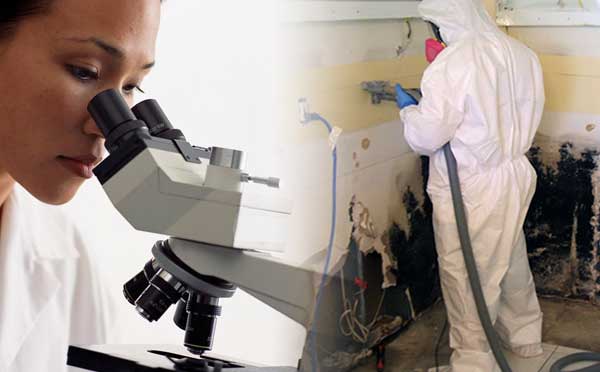The indoor environment caused by water intrusion resulting in microbial growth is very complex. The microorganisms consist of fungi (mold), bacteria, protozoa, beta glucans and other possible contaminants. Of these, mold (fungi) can be highly visible. The visibility of the mold has led to emphasis on their presence and adverse health effects. However, the bacteria can be pathogens as well as release toxins and antigens into the indoor environment.
Please refer to other sections of this web site for more details on bacteria, molds, mycotoxins and biocontaminants in damp indoor spaces.
The minimum testing that should be performed regarding microbial growth and water damage is briefly discussed below.
List of Tests for Microbes and Water Damage
Water intrusion into homes and buildings leads to growth of both fungi and bacteria. Considerable information and media coverage has covered the fungi that are present. However, what the public does not realize (and the media does not cover) are the bacteria that are present.
It is important to note that testing for fungal spores in the indoor air is insufficient to determine which microorganisms are present in your water-damaged home or building.
1. Air Sampling – Fungi and Bacteria
The indoor air should be sampled for airborne fungal spores and bacteria under two different conditions:
(1) Viable spore traps that can be counted for spores per cubic meter and cultured for Gram negative and positive bacteria. This is done as the home is normally occupied.
(2) Use a compressed sterile air canister and disturb the indoor environment causing settled dust to be re-suspended. Perform the counts and cultures as described in (1) above.
You must be aware that air sampling for mold spores is not very reliable. It only tells what is in the indoor air at the time of sampling. It does not necessarily identify all mold because some growth can be hidden in wall spaces, attics and other areas. Therefore, additional sampling is recommended (see below).
2. RealTime PCR-DNA, bulk and dust samples
This test should be performed on two types of samples: (1) household dust and (2) bulk samples.
It is recommend that you collect dust from areas that do not normally get cleaned, such as on top of kitchen cabinets, behind washers and dryers, grates on the backside of the refrigerator, the under side of carpets, etc.
Bulk samples should be taken of visible mold growth.
Put both samples in a zip lock bag, label with date, time and the location where the samples were taken. Send the samples to a laboratory that does the EPA ERMI test. Do the full test for 36 species of fungi. Do not rely on the Moldiness index, which has not been validated. You are only interested in the species of various molds identified by PCR analysis.
2a. Bulk Samples: Bulk sampling can be done. All one needs to do is to bag the bulk sample in a zip lock bag and label it as to date, time and type of sample. For example, bulk samples can include pieces of dry wall, shoes, wall paper, rugs, etc., that have visible growth. It is recommended that the bulk sample be subjected to PCR analysis for mold species, tested for mycotoxins and cultured for bacteria.
2b. Dust Samples: More than one dust sample for PCR and mycotoxin testing should be taken. Two types of dust samples are recommended--referred to as historical and current.
Historical dust samples are taken from areas that do not get cleaned on a regular basis. Examples are: refrigerator coils, screens, condensation pans, under washing machines and clothes dryers, hot water closet and under the bed.
Current dust samples can be taken from places that undergo regular dusting and cleaning.
Testing should include PCR for mold species, detection of mycotoxins and culturing for spore-forming pathogenic bacteria.
3. Bacteria
Both Gram negative and positive bacteria grow along with the fungi.
Gram negative bacteria are potential human pathogens causing respiratory and other infections. Culture on blood agar plates at 37 oC and 50 oC. Thermophilic bacteria will grow at 50 oC and will be crowded out at 37 oC. Thermophilic Gram negative bacteria are also potential human pathogens.
Gram positive bacteria include Bacillus species, Streptococcus, Staphylococcus, Micrococcus and several different Actinomycetes. The Actinomycetes consist of several genera including Streptomyces, non-tuberculin Mycobacterium, Nocardiosis and a few other genera. Cultures for these organisms should be at 37 and 50 oC.
Be sure to inquire with the microbiologist of the laboratory you select that they can culture and identify the bacteria listed above. The Actinobacteria can cause serious health conditions such as hypersensitivity pneumonitis, mycobacterium avium complex and infections that produce small tumor like growths called mycetoma.
4. Endotoxins and 1-3-beta-D-glucans
Endotoxins are lipopolysaccharides that are present in the cell wall of Gram negative bacteria. They are known to be synergistic to the toxic effects of mycotoxins. When Gram negative bacteria die, the cell wall lysis releasing the endotoxins into the environment. These are inflammatory agents and can severely exacerbate lung disease if inhaled. Their presence can be tested in the dust samples.
1-3-beta-D-glucan (glucans) are polysaccharide components of the cell wall of fungi. They are shed into the environment upon the death of fungi. Also, fungal mass shed tiny particles that contain the glucans. The glucans are irritating to the upper and lower respiratory tract. They can be identified in dust samples.

